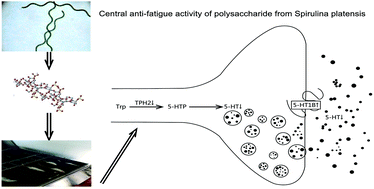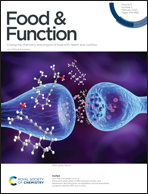Analysis of the anti-fatigue activity of polysaccharides from Spirulina platensis: role of central 5-hydroxytryptamine mechanisms†
Abstract
This study evaluated the effects of polysaccharides from Spirulina platensis (PSP) on endurance during treadmill exercise; levels of some biochemical indicators including hemoglobin (Hb), lactic acid (LA), creatine kinase (CK), and blood urea nitrogen (BUN); concentrations of 5-hydroxytryptamine (5-HT); and expressions of second isoforms of tryptophan hydroxylase (TPH2) and serotonergic type 1B inhibitory autoreceptor (5-HT1B) in the caudate putamen of exercising rats. Sixty Sprague–Dawley male rats were randomly divided into six groups: control group, exercise group, exercise and PSP (50, 100, or 200 mg kg−1)-treated groups, and exercise and caffeine (10 mg kg−1)-treated group (positive control). In the exercise groups, rats were put on a treadmill and forced to run for 30 min once a day for 6 consecutive days. On the 7th day of the experiment, time to exhaustion during the treadmill exercise was determined for the trained groups. Immediately after determination of the exhaustion time, all rats were sacrificed. Levels of Hb and LA were tested by the HiCN (Hemoglobin ferricyanide) colorimetry method and a colorimetric assay, respectively. Levels of CK and BUN were determined by automatic biochemical analyzer. 5-HT concentrations were detected by HPLC analysis. TPH2 and 5-HT1B expressions were measured by western blotting and real-time PCR. The results demonstrated that PSP prolonged the time to exhaustion during the treadmill exercise; increased Hb levels; decreased LA, BUN, and CK levels in the blood; suppressed the exercise-induced increase of 5-HT concentrations and TPH2 expression; and prevented the exercise-induced decrease of 5-HT1B expression in the caudate putamen. The most potent effects were observed at the PSP dose of 200 mg kg−1. These results suggest that the mechanism of promotion of physical performance by PSP might be related to increase in Hb levels; decrease in LA, BUN, and CK levels in the blood; inhibition of the exercise-induced 5-HT and TPH2 expressions; and the increase in the 5-HT1B expression in the caudate putamen of exercised rats.


 Please wait while we load your content...
Please wait while we load your content...